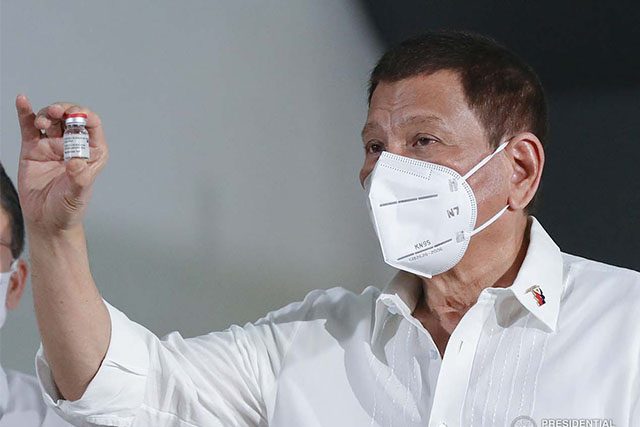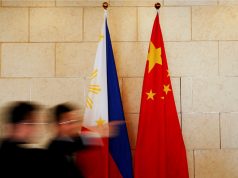
President Rodrigo Duterte was two hours late in personally welcoming the arrival of the AstraZeneca COVID-19 vaccines in contrast with his punctuality when China delivered its doses of Sinovac‘s CoronaVac.
The chief executive on Thursday night was expected to spearhead the vaccine turnover ceremony of Britain’s AstraZeneca doses courtesy of the World Health Organization‘s COVAX Global Facility.
The COVAX initiative ensures that countries around the globe, especially the low and middle-income ones, have equitable access to COVID-19 vaccines.
Reports said Duterte was supposed to be at the Villamor Air Base in Pasay City at 7:30 p.m. The vaccine shipment containing 487,200 doses arrived around 7:20 p.m. at the Ninoy Aquino International Airport Terminal 3.
The president only arrived at around 9:30 p.m. or two hours later.
Diplomats who waited for the Philippine president’s arrival were new European Union Ambassador Luc Veron and British Ambassador Daniel Pruce.
Also present was WHO Representative to the Philippines Dr. Rabindra Abeyasinghe.
A Malacañang staff said that Duterte had a meeting at the Palace but its details were not clear.
He went back to the Palace after attending two events in Bulacan and Valenzuela City that ended at around 5:30 p.m.
At the turnover ceremony, Duterte delivered a speech where he thanked the donor countries and urged Filipinos to get vaccinated since this is the “key to reopening our society.”
The AstraZeneca doses were “immediately” delivered to storage for repacking and preparation for distribution to the frontliners, according to vaccine czar Sec. Carlito Galvez Jr.
Its shipment was donated by the European Union, Germany, Norway, France, Italy, Spain, Netherlands, Sweden, Denmark, Austria, Greece and Australia.
AstraZeneca’s COVID-19 vaccine
The vaccine, which was developed by the pharmaceutical firm together with the University of Oxford, has an average efficacy rate of 70% in trials. The results ranged between 62% and 90% efficacy depending on the vaccine dosage.
A chief medical adviser of Health Canada said that one data for the AstraZeneca showed that efficacy rises to 85% if the gap between doses is 12 weeks. If it’s just four weeks, efficacy was 62%, as reported by CTV News.
The vaccine is also the one most procured by some of the country’s local government units due to its affordability and easy storage requirement at normal fridge temperature, compared to its contemporaries from other pharmaceutical firms.
READ: Juxtaposed: National gov’t procures Sinovac vaccines while some LGUs ink deal with AstraZeneca
‘Not from China’
Compared to his arrival in welcoming AstraZeneca, Duterte was reportedly punctual in overseeing the turnover ceremony of China’s 600,000 Sinovac doses on Sunday.
The aircraft carrying the vaccines landed on the Villamor Air Base that day at 4:10 p.m.
READ: Philippines receives Chinese vaccine, but Duterte prefers another brand
Duterte and his Cabinet members have witnessed the arrival.
He also said that he would like to visit Chinese President Xi Jinping at the end of the year to thank him for the vaccine donation.
Because of this, Duterte’s punctuality during Sinovac jab turnover ceremony was compared to his late arrival during the receipt of AstraZeneca vaccines, which was delivered by Western countries.
“Hindi daw kase galing sa China!” a Twitter user quipped in response to reports about his lateness.
“Pag hindi galing China, hindi priority? Okay lang ma-late? Here we are, worrying ’bout storing them in a certain degree and from turnover time,” another online user said.
“Syempre! Hindi kasi galing sa BFF niya,” a different Filipino likewise commented.
Since he took office in 2016, Duterte has made it known that his administration will have an “independent” foreign policy following his announcement of “separating” from the United States, the country’s traditional defense ally.
He then welcomed “unorthodox partnerships” with China and Russia, despite the continuous encroachment of the former in the country’s exclusive economic zone (EEZ) at the West Philippine Sea.
Last year, Duterte thanked Xi for his “continuous support” to the country amid the pandemic despite the reported activities of Beijing in the disputed territories that time.
China has been aggressively claiming territories in the West Philippine Sea despite the 2016 UN tribunal ruling that recognizes the Philippines’ sovereign rights over such contested areas in its EEZ.









